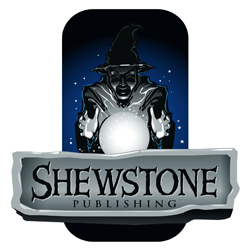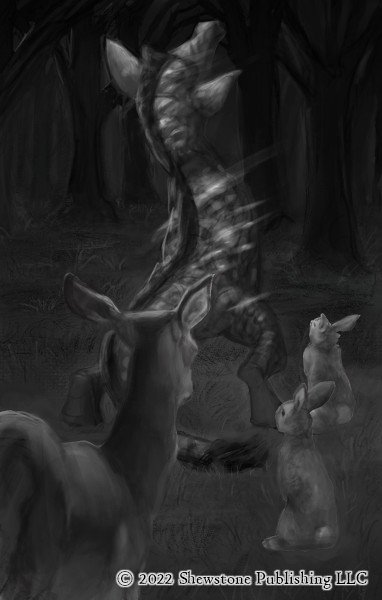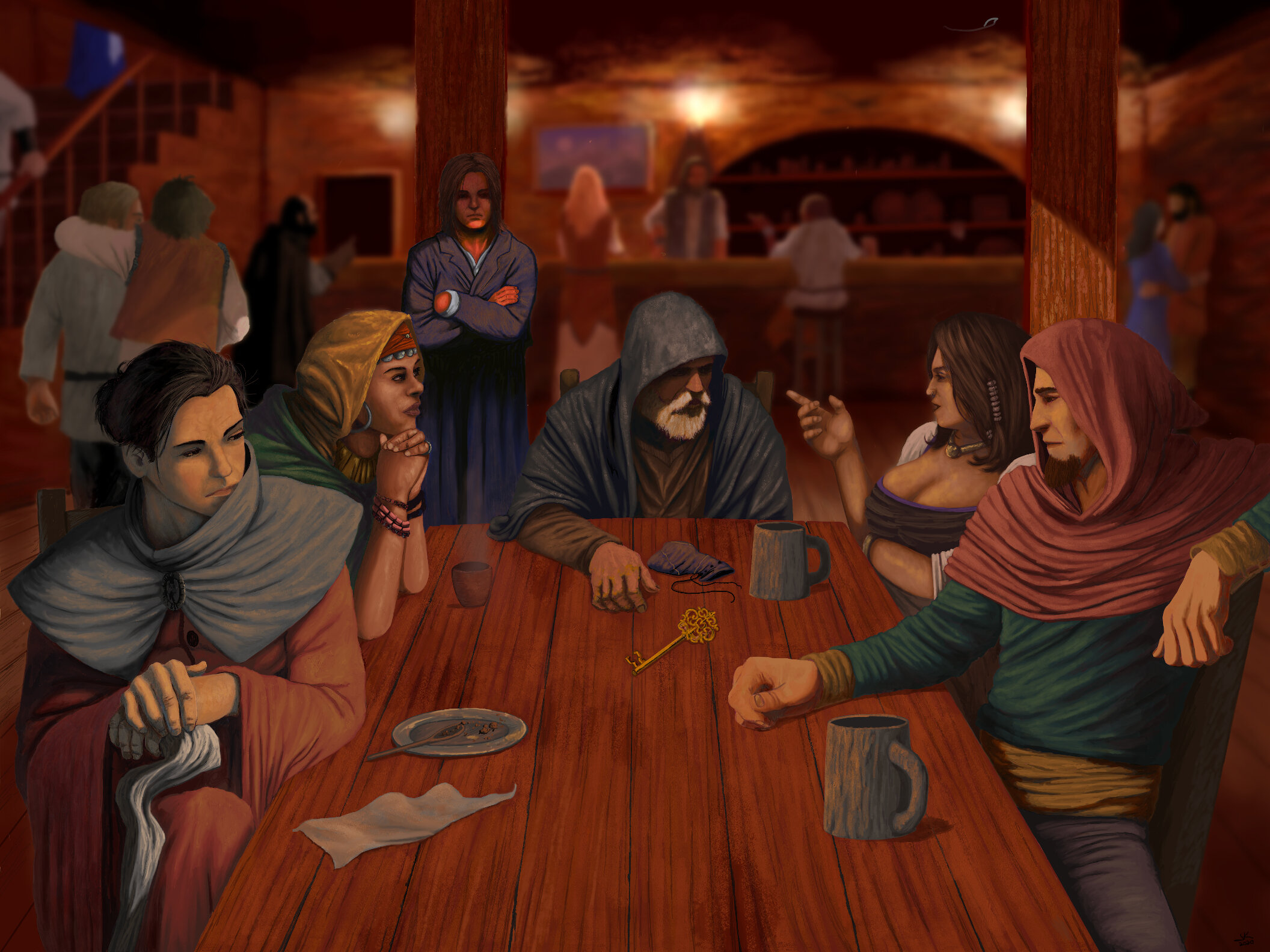Shewstone Publishing has been a lot quieter than planned this year: we’ve only sent one issue of our “monthly” newsletter so far, and our posts to social media have been relatively few. We’ve been hard at work and have more game and setting content in the pipeline than ever, but for a couple of reasons we haven’t felt free to talk about it. Hence the choice of the Hanged Man for this year’s tarot card—we’ve been sort of suspended as a consequence of certain choices.
2023 Book Release: A Bestiary of Enchanted England
First some good news: A Bestiary of Enchanted England was released on December 10! If you missed the Kickstarter (back in November 2022), you can now purchase this title on DriveThruRPG.com.
This is not your typical RPG bestiary. Folklore experts have gone off the beaten path to uncover authentic but little-known legends such as Eala, the haunted swan harp; Kenidjack, the bright-eyed demon of Cornwall; the Laidly Toad Queen; and the mysterious Merchicken of Portland! Familiar favorites such as elves and the afanc have been updated from their medieval origins to imagine them adapted to a Renaissance world. This book is full of lore, plot hooks, and illustrations to help make each of these 37 creatures the centerpiece or a truly memorable story.
$12 PDF / $22 print-on-demand
I’m very proud of the work the writing and graphics teams did with this book. In addition to the fascinating lesser-known lore our very knowledgeable authors selected, I think this book shows two of the strengths of Shewstone’s brand as a whole:
Deep lore, which in this case means authentic legends from the British Isles.
Story ideas a gamemaster can use. Every creature has at least 3 story seeds accompanying it.
Even if you’re not planning to start a Magonomia® game right away (though, friendly reminder, it is New Year’s resolution time), this book should have plenty to inspire your TTRPG campaign. The wait is over! Get your copy today.
Drintera™ is Preparing for Soft Launch on Patreon
Drintera™ is Shewstone Publishing’s original fantasy TTRPG setting, developed by a diverse team of self-proclaimed history, anthropology, folklore, and fantasy nerds from across four continents. We’re getting ready for a soft launch on Patreon in spring of 2024, or earlier if the dice are in our favor.
A “soft launch” means we’re not ready for a full-blown marketing campaign, but people who truly want to support Shewstone’s ongoing creative work will be able to subscribe. Right now there isn’t much on our Patreon page but you can sign up for updates there, or subscribe to our newsletter.
The distinctive characteristics of Drintera are emerging.
An original mythology and cosmology that captures the dreamlike quality of myth.
Heroic theme: adventures are about using your talents to perform great deeds.
The world is full of ever-changing magical forces that even the gods don’t control.
Age inclusive: youth friendly, but deep and intelligent enough to keep adults coming back.
We haven’t posted much about the work in progress because we want to get the tens of thousands of words we’ve written sent off to the U.S. Copyright Office before we start posting them to World Anvil one article at a time. This is some of what we’ll have ready to start incrementally releasing in a couple of months:
Eight of twelve gods from the Council of Heaven.
Two countries for starting adventures: the mountain kingdom of Altostrache in Niere (our Europe-like continent), and the ancient and mighty Twin Moons Empire in Mor Thia (our Asia-like continent).
The world map featuring five continents and two major archipelagos.
Two magnet locations for starting adventurers.
Original cultures for 2 human ethnic groups, 1 group of elves, 1 dwarf culture, and 1 orc culture (with another orc culture about to get started).
17 pieces of original color art.
In short, it’s coming together well. Starting in mid-January (a couple of weeks from now!) we’ll begin regular updates.
Suspending EPUB Format
We published A Bestiary of Enchanted England in both PDF and EPUB formats (both formats are included in price of the digital edition). This will be our last product that uses EPUB format. We’re planning to publish in PDF only for future releases.
Our layout freelancer, Chris Hopper, did a great job with the EPUB version. I think he worked harder for it than he should have to. Shewstone Publishing has high visual standards for layout and graphic design. Elements like text boxes, dividers, and spot illustrations add a lot to the gamer’s experience with the book. It takes a lot of fiddly detail work to get those to flow properly in EPUB format, especially across multiple devices with multiple screen sizes. At the end of the day, the best way we found to get an EPUB book to render the sophisticated layout properly is to force it into fixed-width format.
At that point, the EPUB behaves the same as a PDF. All the major e-reader apps and devices do a good job displaying PDF, so the extra work to produce EPUB layout doesn’t seem like a good investment.
Stormy Weather in the Tabletop RPG Industry
You may remember that 2023 started off with leaked rumors that Wizard of the Coast was planning to terminate, or “de-authorize,” the Open Game License 1.0a. If you weren’t following the online discourse and/or news at the time, I don’t imagine a thorough recap will interest you now. The upshot is that the Open Game License, abbreviated OGL, enabled a thriving community of third-party publishers to make original content compatible with Dungeons & Dragons for over 20 years. Then, like Darth Vader said to Lando in The Empire Strikes Back, some executive at Wizards of the Coast said “I am altering the deal.”
This didn’t directly affect Shewstone Publishing very much, but the indirect impact was substantial. We actually had a marketing plan to promote Magonomia (our awesome RPG of Renaissance wizardry) at the start of the year, and the sound and fury of this controversy made it impossible.
New, truly open games have emerged to scoop up the customers and, importantly, rally the small creators who were driven away by WotC’s betrayal. Kobold Press’s Tales of the Valiant is the open gaming spinoff from 5E just like Paizo’s Pathfinder was the spinoff from 3.5E.
Since the start of a new year is a time for predictions—Shewstone is an archaic word for a crystal ball, after all—I’ll forecast that 2024 and beyond will see increased awareness and acceptance of other fantasy TTPRG systems besides the D&D brand. The iron rule of the Wizards of the Coast is not ended, but it is weakened. We’ll be ready with the Drintera setting. Bring your favorite rules and your favorite small press supplements to Drintera. The Age of Destiny is approaching!
New Blog Series - GM’s Duct Tape
A week before Christmas we started a new series of short articles called “GM’s Duct Tape.” It’s short nuggets of advice from my (Andrew’s) and my often-silent partner (Vesna)’s decades of experience as gamers and gamemasters. Our “duct tape” solutions are quick fixes you can apply in the moment. The first article in the series was what to do when the player characters run to their sponsor to solve their problems. There will be many more to come, at least monthly. Join us on Discord or social media to share your thoughts on our advice or to ask us about your GMing challenges. Maybe we can fix the problem with duct tape!
Our Social Media Links
We quit Twitter in 2022 when the getting was good. We have zero regrets but we do fondly remember the TTRPG community that was.
Here are our current social media channels where we’re (intermittently) active:
Discord - Shewstone has its own server
Mastodon - @Shewstone@dice.camp
Facebook - ShewstonePublishing
Instagram Threads - @shewstone_llc
Bsky - @shewstone.bsky.social
We also have our email newsletter which will be more frequent in 2024!
Magonomia® Next Release - 101 Adventure Seeds
Our next full-length supplement for Magonomia is tentatively titled 101 Adventure Seeds in Enchanted England.
An adventure seed is a well developed outline of an adventure that the GM can easily finish by adding specific opponents, maps, and other details. They’re somewhat like our former Tales of Wizardry blog posts, but more concise. Each adventure seed is designed to require 1/2 hour or less of setup. Because you complete the setup yourself, they’re playable in any game system.
The idea, which we’re testing in the marketplace, is that experienced gamemasters are always looking for cool adventure ideas. Compared to fully-developed, ready-to-play adventure scenarios, adventure seeds:
Are quicker to read and decide whether and how you want to use them
Are much less expensive to write, so you can buy 101 of them for the price of a single book
Easily fit into a single game session
Require about the same amount of work to customize
101 Adventure Seeds in Enchanted England will be marketed as a system-neutral toolkit for any fantasy game, but never fear. Our history and folklore nerds are building in plenty of authentic tie-ins to the rambunctious, sometimes delightful, sometimes appalling Elizabethan period!
Right now we have a first draft of 89 of 101 adventure seeds. I’d love to say this book will be ready for a fall 2024 Kickstarter but that seems optimistic at this point. Playtesting is just starting. We learned from A Bestiary of Enchanted England that we really need the manuscript to be fully playtested and layout ready before we launch the crowdfunding campaign. Otherwise there’s too much that can go wrong and delay fulfillment. We’ll be previewing the adventure seeds over the coming year, but the book will be ready when it’s ready.
Getting Communications Back on Track
We were running silent in 2023 mostly because the Kickstarter fulfillment for A Bestiary of Enchanted England was 6 months late getting to backers. I don’t love that we were late but we’re far from the only small publisher to experience that. We did learn from the experience — layout takes longer than one might expect, and it can’t be rushed.
When I back a Kickstarter, I hate when the creator falls behind and then gushes about all the other cool projects they’re working on except the one I paid for. (It’s doubly annoying when they abuse the Kickstarter updates to hawk those projects.) So I held back on publicity until A Bestiary of Enchanted England was out the door. This was a self-inflicted wound. I feel I was acting on the right principle, but this was definitely a setback for our still-fledgling marketing efforts.
In 2024 we’ll be turning over a new leaf. As you can see, we have two cool projects in the works, and they’re both of a nature where we can preview content practically every month. That and the “GM’s Duct Tape” column will give us plenty that’s worth talking about. Here’s our newsletter link one more time so you don’t have to scroll back and look for it.









